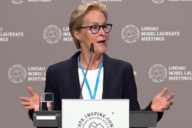You have /5 articles left.
Sign up for a free account or log in.
Once, when I was in high school, I must have said something that particularly exasperated one of my teachers. She took a deep breath and looked out at me in the classroom (middle seat, second row) and said “Rosemarie, do you know what you are? You are in intellectual iconoclast.”
I didn’t really know what that meant, but soon discovered that an iconoclast is one who tries to destroy icons, be they actual icon paintings or intellectual ideas. I long ago began to take pride in that label given to me when I was so young. After all, what would be a better job description for us as scholars than “intellectual iconoclast”?
I thought of that teacher when I recently had the opportunity to read a book about statistics written by a popular professor from my college days, Othmar Winkler. He was a “statistics guru” on our college campus, and THE professor known for teaching statistics in the business school. He recently wrote a book called “Interpreting Economic and Social Data”, and I devoured his book as I recovered from my injuries. This is not an ordinary statistics text book, but one that instead dares to put some of the accepted techniques of statistics under a microscope. Ideas that are generally accepted among those using statistics for economics and the social sciences, such as index numbers to least squares regression are examined closely as the author offers ways that statistics in the social sciences can be improved. After all, it proposes, the social sciences are very different from the natural sciences. We social scientists cannot perform a social experiment and then repeat it in the lab, as can chemists.
I again thought of that former teacher recently when my daughter decided that some of her treasured stuffed animals should go to church. She lined them up on the stairs; Pink Kitty, Teddy and Teddy’s “sister”, a stuffed dog that looks a lot like Teddy. With her presiding, they all went to church, complete with bread intended for sandwiches and grape fruit juice. As I watched her play church, I was at the same time both heartbroken and hopeful. I was heartbroken because I realized that she had obviously not realized that all of the priests at church were always men, and that there had never been a priest who looked like her or any of the other females in her life. On the other hand, I was also hopeful, because I saw in her actions the start of what could someday be the first generation of Catholic women to break the Stained Glass Ceiling. Perhaps my daughter would grow up to be an iconoclast that would bring about change in her church, and through that, in the larger world.
Being an iconoclast is not without price, as sometimes others are not ready to hear ideas that are not generally accepted. Realizing, I am sure, how controversial some of these original ideas might be, the author of the statistics book begins the preface of the book with a quote. This quote reminds all of us scholars that our duty is not primarily to be accepted, but, rather, to search for the truth, wherever it may be:
“It is the responsibility of scientists to never suppress knowledge, no matter how awkward that knowledge is, no matter how it may bother those in power. We are not smart enough to decide which pieces of knowledge are permissible and which are not…” -Carl Sagan

